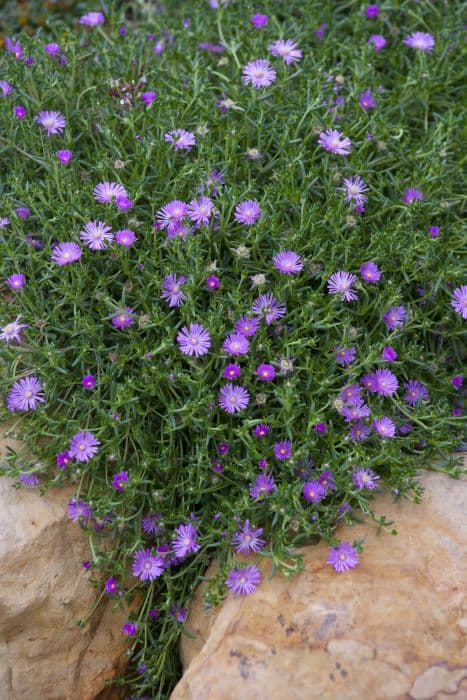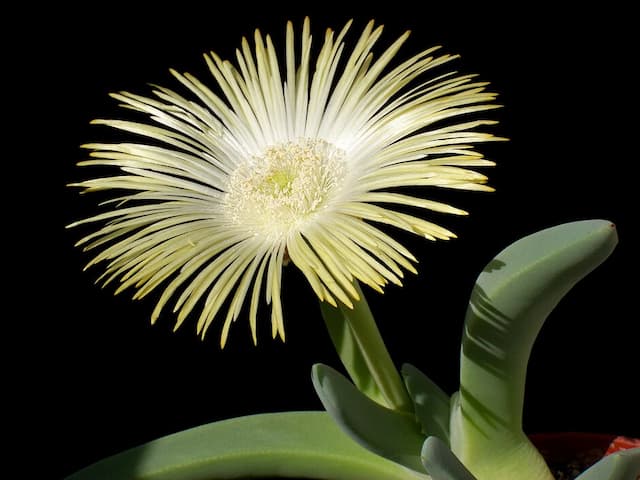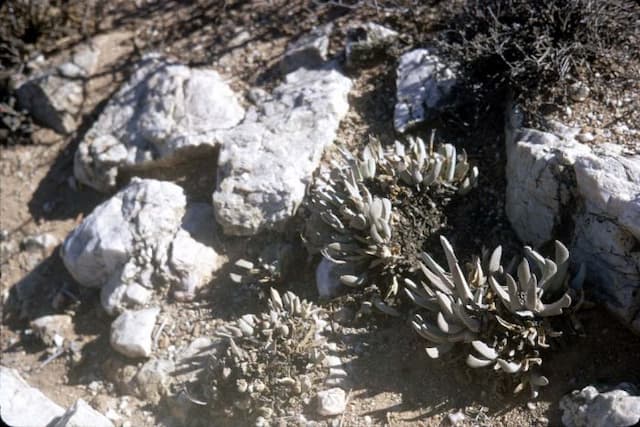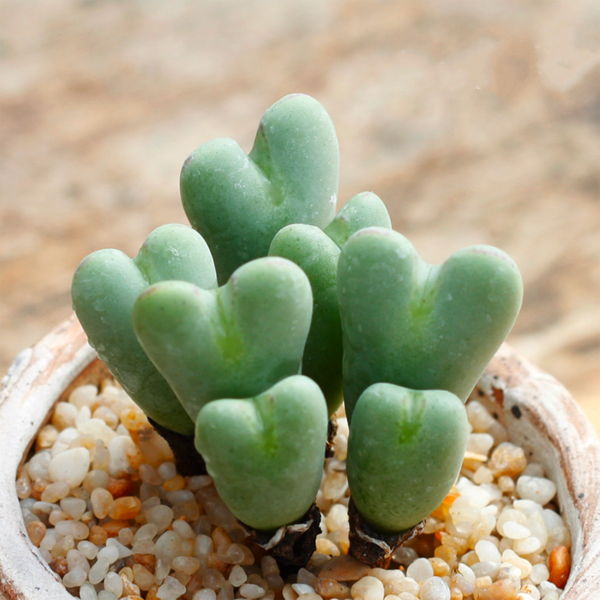Ice Plant Delosperma cooperi 'Jewel of Desert Garnet' (PBR) (Jewel of Desert Series)

ABOUT
The Jewel of Desert Garnet is part of the Jewel of Desert series, known particularly for its vibrant and colorful flowers. The appearance of this plant is marked by its eye-catching blooms which present an alluring combination of rich pink to garnet-red petals, radiating from a center of white and yellow tones. The petals are numerous and create a daisy-like floral form that is both lush and delicate. The glossy succulent foliage, typically green in color, offers a striking contrast against the bright flowers, offering a lush backdrop for the vibrant blossoms. The overall look of this plant exudes vibrancy and is famously used in rock gardens and as ground cover due to its spreading nature and floriferous display.
About this plant
 Names
NamesFamily
Aizoaceae.
Synonyms
Cooper's Ice Plant, Trailing Ice Plant, Pink Carpet, Hardy Ice Plant.
Common names
Delosperma cooperi
 Toxicity
ToxicityTo humans
Ice plant, commonly known as Delosperma cooperi, is not considered toxic to humans. There are no well-documented cases of poisoning from ingesting this plant. Therefore, consuming parts of the ice plant is unlikely to cause harmful effects in humans. However, it is generally not recommended to eat ornamental plants due to the potential for pesticides and other chemicals that may be on the plant.
To pets
Ice plant is also not known to be toxic to pets. It does not contain substances known to cause harm to dogs, cats, or other domestic animals if ingested. Consumption of the ice plant by pets should not lead to poisoning or serious health issues. However, ingestion of plant material can sometimes cause mild gastrointestinal upset in some animals due to the unusual materials in their diet.
 Characteristics
CharacteristicsLife cycle
Perennials
Foliage type
Evergreen
Color of leaves
Green
Flower color
Mixed
Height
0.2 feet (6 cm)
Spread
2 feet (60 cm)
Plant type
Succulent
Hardiness zones
6
Native area
South Africa
Benefits
 General Benefits
General Benefits- Drought Tolerance: The plant is highly drought-tolerant, making it an ideal choice for water-wise gardens and for gardeners seeking low-maintenance landscapes.
- Easy to Grow: It requires minimal care and can thrive in a variety of soil types, as long as they are well-drained.
- Attractive Blooms: Produces vibrant daisy-like flowers, which can add a splash of color to rock gardens, borders, and containers.
- Ground Cover: Functions as an effective ground cover, spreading to fill spaces and suppress weeds with its dense mat of succulent leaves.
- Long Flowering Season: Has a lengthy blooming period from late spring to the first frost, providing extended visual interest in the garden.
- Cold Hardy: Can withstand cold temperatures, making it suitable for many climates and extending its range beyond that of many other succulents.
- Heat Resistant: Thrives in hot, sunny conditions, which is beneficial in urban landscapes and regions with high summer temperatures.
- Pollinator Friendly: Attracts bees, butterflies, and other pollinators, supporting local ecosystems and biodiversity.
- Deer Resistant: Less appealing to deer, which helps prevent damage from grazing in areas with a deer population.
- Low Fertilizer Needs: Does not require frequent fertilization, thus reducing maintenance time and the need for chemical inputs.
 Medical Properties
Medical PropertiesThis plant is not used for medical purposes.
 Air-purifying Qualities
Air-purifying QualitiesThis plant is not specifically known for air purifying qualities.
 Other Uses
Other Uses- Photography Prop: Its vibrant blossoms and succulent foliage can serve as a splendid subject or backdrop for macro and garden photography enthusiasts.
- Pressing and Craft: The flowers and leaves of Delosperma cooperi can be gently pressed and used for creating botanical art or in scrapbooking projects.
- Educational Resource: This plant can be studied in botany classes to demonstrate adaptation mechanisms of succulents in arid environments.
- Living Mulch: This groundcover plant can be used in gardens to help retain soil moisture and suppress weed growth.
- Insect Habitat: Offering a safe haven for beneficial insects, the dense mats of this succulent can help support local biodiversity.
- Artistic Inspiration: Artists may draw inspiration from the vibrant colors and textures for various forms of art like painting or textile designs.
- Jewelry Making: The dried flowers could potentially be used in making unique, botanical-based jewelry pieces.
- Theme Gardens: Incorporated into rockery or xeriscaping designs, it enhances themed garden landscapes focused on drought tolerance.
- Erosion Control: Planting Delosperma cooperi on slopes can help prevent soil erosion due to its mat-forming growth habit.
- Culinary Garnish: Although not commonly eaten, the flowers could be used as an edible garnish for their aesthetic value on special dishes in high-end culinary presentations.
Interesting Facts
 Feng Shui
Feng ShuiThe Ice Plant is not used in Feng Shui practice.
 Zodiac Sign Compitability
Zodiac Sign CompitabilityThe Ice Plant is not used in astrology practice.
 Plant Symbolism
Plant Symbolism- Perseverance: The ice plant, which includes Delosperma cooperi 'Jewel of Desert Garnet', is known for its ability to survive in tough, drought-like conditions, symbolizing the ability to endure and thrive despite challenges.
- Vitality: With its vibrant flowers and succulent leaves, the ice plant represents life and energy, as it flourishes in sunny environments and often has a lively appearance.
- Beauty and Appreciation: The jewel-like quality of its blooms and its ornamental value in gardens symbolize the beauty found in nature and the appreciation of it.
- Hospitality: In some cultures, the ice plant is believed to signify a warm welcome and friendliness, possibly due to its lush and inviting appearance.
 Water
WaterFor the Ice Plant, or Hardy Ice Plant, you should water sparingly, as it is a drought-tolerant succulent. Established plants typically need watering only every two weeks during the growing season if there is no rainfall. The method of watering should mirror a light rain, soaking the soil to a depth of about one inch but ensuring that the plant is not left sitting in water. During the winter dormancy, water only if the soil is completely dry. An approximate amount could be up to a half a gallon per square foot every two weeks, adjusted based on rainfall and temperature conditions.
 Light
LightThe Ice Plant thrives best in full sun exposure, which means it should receive direct sunlight for at least six to eight hours per day. The plant is well-suited for a sunny spot in the garden that is free from shade-casting structures or trees. It will produce the most vibrant blooms and strongest growth when provided with plenty of sunshine.
 Temperature
TemperatureThe Ice Plant prefers warm conditions and is hardy in zones 5 through 10. It can tolerate minimum temperatures down to about -20 to -30 degrees Fahrenheit, although it may need protection from extreme cold. The ideal temperature range for this plant is between 60 and 80 degrees Fahrenheit during its active growing season. It is well-suited for temperate regions with hot summers and cooler winters.
 Pruning
PruningPruning the Ice Plant helps to maintain its shape, encourage bushier growth, and remove any dead or damaged foliage. It's best to prune in early spring, just as new growth begins to emerge. Pruning can be done lightly throughout the year as needed to remove spent flowers and keep the plant tidy. Deadheading flowers after blooming can encourage further blooming throughout the season.
 Cleaning
CleaningAs needed
 Soil
SoilIce plant thrives best in a well-draining soil mix composed of sand, potting soil, and gravel or perlite in equal parts. It prefers a slightly acidic to neutral pH of around 6.0 to 7.5 for optimal growth.
 Repotting
RepottingIce plants should generally be repotted every two to three years to replenish the soil and give their roots more space to spread.
 Humidity & Misting
Humidity & MistingIce plant prefers low to average humidity conditions, as it is adapted to dry, desert-like environments.
 Suitable locations
Suitable locationsIndoor
Place in bright light, avoid overwatering, ensure pot has drainage.
Outdoor
Full sun, well-draining soil, space 15-20 cm apart.
Hardiness zone
6-9 USDA
 Life cycle
Life cycleIce Plant begins its life as a seed, typically germinating when soil temperatures are warm and there's sufficient moisture. Seedlings emerge and develop into a dense, mat-forming perennial with fleshy, succulent leaves which contribute to its drought tolerance. The plant enters a vegetative stage where it focuses on leaf and root growth, establishing a robust system to support flowering. Blossoming usually occurs in late spring to summer, displaying vibrant daisy-like flowers with petals often in shades of pink or purple, attracting pollinators. After pollination, the flowers produce capsules containing seeds, completing the reproductive cycle. The plant then goes into a period of dormancy during colder months, reducing growth significantly until favorable conditions return.
 Propogation
PropogationPropogation time
Spring-Summer
The Ice Plant, commonly referred to as Delosperma cooperi 'Jewel of Desert Garnet', is most frequently propagated through cuttings. The optimal time for taking cuttings is during the warmer months when the plant is actively growing, usually late spring through early summer. To propagate by cuttings, a gardener would select a healthy, non-flowering stem and snip it off using a clean, sharp pair of scissors or pruning shears, making the cut about 2 to 4 inches (approximately 5-10 centimeters) long. The cutting should then have its lower leaves removed and be allowed to callous over for a day or two to reduce the risk of rot. After the callous forms, the cutting is placed in well-draining soil, kept moist, and provided with plenty of indirect sunlight until roots develop and new growth begins.


![Ice plant [Fire Spinner]](/_next/image?url=https%3A%2F%2Fplants-admin.emdemapps.com%2Fimages%2Fplants%2F%2Fimages%2F604b54d98722a.png&w=640&q=75)






